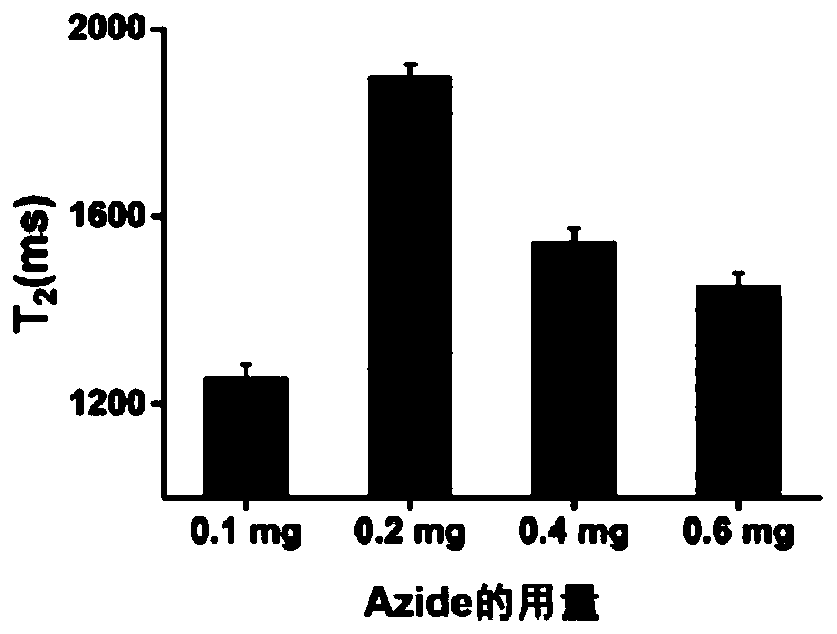Method for detecting pesticide residues by using magnetic relaxation time sensor based on quantity and state change of nano magnetic particles
A nano-magnetic particle and state change technology, which is applied in the direction of immunodiagnostic reagent carriers, instruments, and measuring devices of magnetic particles, can solve the problem of changing the number of magnetic particles, and achieve the effects of simple operation, fast detection speed, and simple pretreatment
- Summary
- Abstract
- Description
- Claims
- Application Information
AI Technical Summary
Problems solved by technology
Method used
Image
Examples
Embodiment 1
[0046] Example 1. Construction of the magnetic relaxation immunosensor
[0047] (1)Azide-MNP 30 Preparation of conjugates
[0048] 100 μL of 15-azido-4,7,10,13-tetraoxopentadecanoic acid-N-succinimidyl ester (Azide-PEG 4 -NHS ester) solution (1mg / mL) was added to 200μL NH 2 -MNP 30 solution (2.5 mg / mL), stirred slowly at room temperature for 1 hour. After the reaction was completed, magnetic separation was performed at 4°C for 12 hours, and the supernatant was removed to obtain Azide-MNP 30 The conjugate was then resuspended in 500 μL of PBST (pH=7.4, 0.01 M, containing 0.05% Tween 20), and this process was repeated three times. Finally, Azide-MNP 30 The conjugate was resuspended in 100 μL of PBS solution (pH=7.4, 0.01 M), and stored at 4° C. for future use.
[0049] In this embodiment, the amount of Azide in the coupling process is optimized, the specific method is as follows: take different quality Azide-PEG 4 -NHS with 1mg MNP 30 Coupled, the resulting Azide-MNP 3...
Embodiment 2
[0061] Embodiment 2. Comparison of the sensitivity of the magnetic relaxation immunosensor with the traditional magnetic relaxation time sensor
[0062] According to embodiment 1, respectively use traditional MRS ( Figure 7 A), MRS based on the change of the number of magnetic particles ( Figure 7 D), and MRS based on the number and state changes of magnetic particles ( Figure 7 G) Detection of gradient concentrations of chlorpyrifos. The specific methods are: (1) Traditional MRS: antibody coupling on magnetic particles (MNP 30 -Ab), and coupled to another magnetic particle complete antigen (MNP 30 -BSA-chlorpyrifos), mix 100 μL of different concentrations of chlorpyrifos solution with 100 μL of MNP 30 -BSA-chlorpyrifos solution, 100 μL MNP 30 -Ab conjugates are mixed, and a competitive immune reaction occurs, causing the aggregation of magnetic particles (MNP 30 -Ab-chlorpyrifos-BSA-MNP 30 , state change), thus causing T 2 value changes. (2) MRS based on the chang...
Embodiment 3
[0064] Example 3. Research on the Specificity and Recovery of the Magnetic Relaxation Immunosensor
[0065] (1) In the specificity test, four chlorpyrifos analogues, dimethoate, triazophos, glyphosate, and chlorpyrifos, were added to measure the specificity of the sensor for detecting chlorpyrifos, so as to verify the specificity of the sensor. Wherein, the concentration of chlorpyrifos is 10 ng / mL, and the concentration of these analogues is 100 ng / mL. Such as Figure 8 As shown, only chlorpyrifos can cause T 2 Significant changes in the value, other analogues have a negligible effect on the magnetic signal.
[0066] (2) The recovery rate was studied by the standard addition method, that is, different concentrations of chlorpyrifos (0.5, 1, 5, 10, 50 and 100 ng / mL) were added to the blank apple sample, and then the sensor was used for determination. As shown in Table 1, the recovery rate of chlorpyrifos detection (76%-119%) also shows the accuracy of the method.
[0067] ...
PUM
| Property | Measurement | Unit |
|---|---|---|
| particle diameter | aaaaa | aaaaa |
| particle diameter | aaaaa | aaaaa |
| particle diameter | aaaaa | aaaaa |
Abstract
Description
Claims
Application Information
 Login to View More
Login to View More - R&D
- Intellectual Property
- Life Sciences
- Materials
- Tech Scout
- Unparalleled Data Quality
- Higher Quality Content
- 60% Fewer Hallucinations
Browse by: Latest US Patents, China's latest patents, Technical Efficacy Thesaurus, Application Domain, Technology Topic, Popular Technical Reports.
© 2025 PatSnap. All rights reserved.Legal|Privacy policy|Modern Slavery Act Transparency Statement|Sitemap|About US| Contact US: help@patsnap.com



